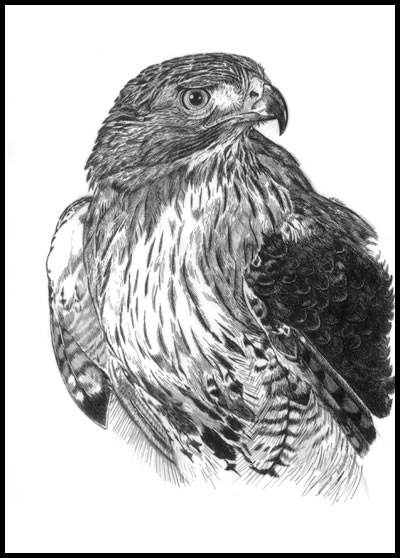| |
| |
| |
| |
| |
| |
| |
| |
| |
| |
RED-TAILED
HAWK Buteo jamaicensis |
 |
| The red-tailed hawk is a high-profile
bird. The species is one of North America's most widely distributed birds
of prey, ranging from Alaska through Central America, and from southern
Quebec down into Florida. This is also a large bird, the second largest
buteo in North America (second only to the ferruginous hawk). Females
may weigh over 3 pounds, while the smaller males average 2 1/4 pounds.
Wingspan is around 4 feet. The wide wingspread is obvious when the bird
is in flight, for contributing to the red-tail's visibility is the fact
that this is a hawk that hunts in open spaces, in contrast to forest-loving
species like the goshawk. The red-tail is a soaring hawk, and may remain
aloft for hours at a stretch, riding the thermals or upwelling currents
of warm air that rise from the ground. Some soaring may simply be done
for the fun of it. However, soaring also serves two useful purposes. One
is that it is energy-efficient, so a great deal of sky can be covered
with a minimum of effort. That makes soaring an ideal way to migrate,
and some red-tails, particularly the northern birds and the immatures,
do migrate as cold weather approaches. However, many adults remain in
their hunting territory throughout the year, which makes them easy to
observe during the winter months. When the red-tailed hawk is soaring,
its trademark chestnut tail, typically spread like a wide, rounded fan,
can be seen to advantage, especially when the bird veers and the tail
glints in the sunlight. However, only mature birds over one year old have
the red tail. Immature birds, also called birds of the year, have a dark
gray tail, marked with several darker bands. Soaring also helps the red-tail to hunt, for it gives the hawk a bird's-eye view of the ground and the movement of prey. The red-tail is an unfussy feeder, one reason for its wide distribution, and it will take anything from reptiles and small birds to rabbits, squirrels and woodchucks. Typical prey is a small rodent like a mouse or vole. When it wishes to get closer to the action, the red-tail descends from the sky to employ another favorite means of spotting its prey - still-hunting. This technique expends, if anything, even less energy than soaring, and its function is the same: it gives the bird an overview of its surroundings. A lookout tree offering an unobstructed view is selected, and this is probably why red-tails are seldom seen perched in evergreens - the needles are too dense to allow the hawk to see unimpeded. Once perched, the red-tail scans the ground intently for the movement of prey. It has keen eyesight that sees the world in far greater detail than our eyes do. Favorite hunting perches, which are often used over and over, are apt to be along the edges of roads or fields. From its vantage point the hawk can monitor rodent activity out in the open. Since the red-tail is frequently seen in trees (and even on streetlights) by the side of highways, people often assume that the bird is waiting for roadkill. While a young red-tail may eat carrion, especially in winter when food is hard to come by, most red-tails leave the roadkill to the turkey vultures. The hawks prefer to catch their own food, and they've found that highways are a good place for hunting. The open road makes prey easy to spot, and the blacktop surface warms quickly, creating thermals for the birds to ride on. Seen perched by passing motorists, the red-tail gives the impression of being a mostly white bird, with a dark bellyband of streaked feathers set off by the pale front. However, individuals vary a great deal. Some lack the bellyband, while others have an orange-red front. Geographical location influences appearance as well. Western birds look very different from red-tailed hawks that live in the Northeast. Some of these plumage differences are so distinctive that the hawks are given different names, such as Harlan's Red-tailed Hawk, Krider's Red-tailed Hawk and Fuertes' Red-tailed Hawk. The red-tail's penchant for haunting roadsides sometimes leads to a collision with a car, and habitat destruction threatens some individuals. In general, however, this highly adaptable species, with its ability to live in a wide variety of habitats, is doing very well. |